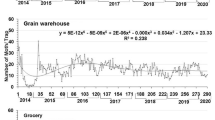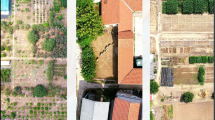Abstract
This paper deals with the Arthropods fauna collected by bait and pheromone traps and categorized during one-year study in a Central Italy feed-mill.
A total of 17,919 Arthropods were collected: Arachnida, Isopoda and Insecta. In the Arachnida we found mites, pseudoscorpions and mostly spiders; while in the Isopoda the only species noted wasPorcellio scaber (Latreille); in the Insecta 9 orders and 33 determined species were associated with the feed-mill: Collembola, Thysanura, Dermaptera, Psocoptera, Rhynchota, Lepidoptera, Coleoptera, Diptera and Hymenoptera.
In the order Lepidoptera about 55% of the insects were collected. Eight species of stored product Lepidoptera were cuaght:Ephestia kuehniella. Zeller, was the most abundant and wide-spread in the feed-mill (with 8,230 males, 83.53% of Lepidoptera trapped) followed byPlodia interpunctella (Hübner), (1,415 males) andEphestia elutella, (Hübner), (161 males). Coleopterans made up 40.43% of the insects collected.Tribolium confusum J. Du Val, was the most abundant and widespread in the feed-mill (with 5,451 specimens, 75.23% of Coleoptera trapped); less abundant wereOryzaephilus surinamensis (L.) (752 specimens),Tribolium castaneum (Herbst) (359 specimens),Attagenus brunneus Fald. (223 specimens),Stegobium paniceum (L.) (156 specimens) andSitophilus oryzae (L.) (118 specimens).
Arthropods infestation level found during this survey were probably directly proportional to the amount of debris present in the departments.
Because of these and other peculiarities, the feed-mill staff have to be continually alert to prevent, detect, and control pest problems within their work environment.
Similar content being viewed by others
References
Arbogast, R. T.;Throne, J. E., 1997: Insect Infestation of Farm-Stored Maize in South Carolina: Towards Characterization of a Habitat. J. stored Prod. Res.33, 187–198.
Dyte, C. E., 1965: Studies on insect infestation in the machinery of three English flour mills in relation to seasonal temperature changes. J. stored Prod. Res.1, 129–144.
Loschiavo, S. R.;Okumura, G. T., 1979: A survey of stored products insects in Hawaii. Proc. Haw. Ent. Soc.13, 95–118.
Maff, 1981a. Storage Pests 1980. Agricultural Science Service Research and Development Report. Reference Book251 (80). H.M.S.O., London, 25–26.
Maff, 1981b. Storage Pests 1980. Agricultural Science Service Research and Development Report. Reference Book251 (80). H.M.S.O., London, 33–34.
Mills, J. T., 1986: Postharvest insect-fungus associations affecting seed deterioration. In: Physiological-Pathological Interactions Affecting Seed Deterioration. Crop Sci. Soc. Am., Madison, Wisconsin, Special Publ.12.
Mills, J. T., 1995: Ecological Aspects of Feed-Mill Operation. In:Jayas, D. S.;White, N. D. G.;Muir, W. E. (Eds.), Stored-Grain Ecosystems. Marcel Dekker Inc., New York, 677–707.
Mills, J. T.;White, N. D. G., 1993: Seasonal occurrence of insects and mites in a Manitoba feed mills. Proc. Ent. Soc. Manitoba49, 1–15.
Pellitteri, P.;Boush, G. M., 1983: Stored-product insects pests in feed mills in Southern Wisconsin. Wisconsin Acad. Sci., Arts Lett.71 (2), 103–112.
Pinninger, D. B., 1975: The use of bait traps for assessment of stored-product insect populations. USDA Coop. Econ. Ins. Rep.25, 907–909.
Richter, K., 1990: Integated pest control in mixed feed production and application in tropical Countries. In:Fleurat-Lessard, F.; Ducom, P. (Eds.). Proc. 5th Int. Work. Conf. Stored-Product Prot., Bordeaux III 1693–1700.
Rilett, R. O.;Weigel, R. D., 1956: A winter survey of Coleoptera in feed and flour mills. J. Econ. Ent.49, 154–156.
Rostom, Z. M. F., 1994: Abundance of insects and mites infesting stored grain and animal feed in Ryadh and Dammam Provinces, Saudi Arabia. Qatar. Univ. Sc. J.14 (1), 103–112.
Sinha, R. N., 1973: Interrelation of physical, chemical and biological variables in the deterioration of stored grains. In:Sinha, R. N.;Muir, W. E. (Eds.), Grain Storage: Part of a System. AVI Publishing Company, Westport Connecticut, 15–47.
Sinha, R. N.;Watters, F. L., 1985: Insect Pests of flour mills, grain elevators and feed mills and their control. Agr. Canada Publ.1776 1–290.
Trematerra, P., 1985: Catture di Artropodi, in un Molino per la lavorazione del frumento tenero. Tecnica Molitoria, 339–345.
Trematerra, P., 1997: Integrated pest Management of stored-product insects: practical utilization of pheromones. Anz. Schädl, Pflanzensch, Umweltsch.70 (3), 41–44.
Trematerra, P.;Sciarretta, A., 1998: Infestazioni di insetti nei cereali stoccati in magazzini tradizionali. Inf. tore agrario25, 69–73.
Wong Corral, F. J.;Cortez Rocha, M. O.;Borboa Flores, J.;Bustamente Andrade, F. 1992: Insect species infesting grain stored in rural communities in the northeast of Sonora, Mexico. Southwestern Ent.17, 327–331.
Author information
Authors and Affiliations
Corresponding author
Rights and permissions
About this article
Cite this article
Trematerra, P., Fiorilli, F. Occurrence of Arthropods in a Central Italy feed-mill. Anz. Schadlingskde., Pflanzenschutz, Umweltschutz 72, 158–163 (1999). https://doi.org/10.1007/BF02767137
Issue Date:
DOI: https://doi.org/10.1007/BF02767137




